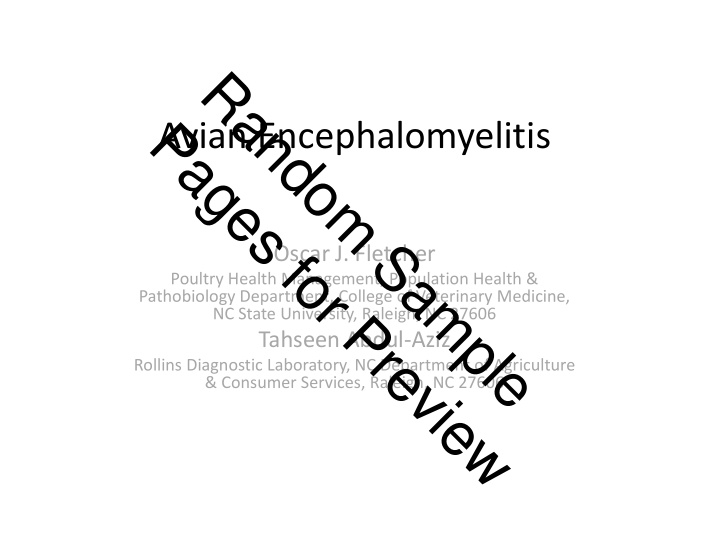



R a P Avian Encephalomyelitis n d a o g m e s S Oscar J. Fletcher f o a Poultry Health Management, Population Health & r Pathobiology Department, College of Veterinary Medicine, m NC State University, Raleigh, NC 27606 P p Tahseen Abdul ‐ Aziz r l e Rollins Diagnostic Laboratory, NC Department of Agriculture e & Consumer Services, Raleigh, NC 27606 v i e w
Avian encephalomyelitis (AE) is an infectious viral disease of young (1 to 3 week old) chickens, turkeys, pheasants, and quail. The causative virus is a member of the R Picornaviridae family. Older chickens may have cataracts as a consequence of AE infection. a Susceptible laying hens can have reduction in egg production and hatchability. Because the P n virus can be transmitted through the egg, immunization of hens is critical for control of this disease. d a Clinical signs in young birds include paralysis, ataxia and rapid tremors of the head and o g neck. The term epidemic tremor is often used for this disease. Older birds show no clinical m e signs. s Gross lesions are limited to white foci that may be seen in the tunica muscularis of the S ventriculus (gizzard). Older chickens can develop cataracts as a result of infection when f younger. o a Diagnosis : The virus replicates in and causes stunting of chick embryos. If infected by AE r m virus, hatched chicks will exhibit neurologic signs. A number of serologic tests can be used P in the diagnosis of AE and include: virus neutralization, indirect fluorescent antibody, p immunodiffusion, enzyme ‐ linked immunoassay (ELISA), and reverse transcriptase ‐ r l e polymerase chain reaction (RT ‐ PCR). Infection in young birds with clinical signs usually e v results in characteristic histologic lesions that are shown in this study set. Not all birds will i have all of the lesions illustrated. The location of brain lesions, especially if central e chromatolysis is present and supporting lesions are identified in the spinal cord and visceral w organs, are diagnostic. Other organs, including spinal cord, proventriculus, gizzard and heart should be examined to confirm that the nodular lymphocytic lesion pattern is characteristic of AE.
R Links to Additional Information a P n d a • Cornell Atlas of Avian Diseases o g m e – http://partnersah.vet.cornell.edu/avian ‐ atlas/ s – This site contains images of stunted embryos and S f o gross lesions in the gizzard. a r m – You will need to enter Avian Encephalomyelitis in P p the disease search box to be directed to the r l e e specific section. v i e w
R References a P n d a • Calnek, B. W. 2008. Avian Encephalomyelitis. In Diseases of o g Poultry. 12 th ed. Y. M. Saif, editor. AAAP. Pp 430 ‐ 441 m e • Wei, Li, Zhou, J., Wang, J., and Liu, J. 2008. Development of a s Non ‐ Radioactive Digoxigenin cDNA Probe for the Detection of S f o Avian Encephalomyelitis Virus. Avian Pathol . 37 (2): 187 ‐ 191 a r m • Welchman, D. Cox, W. J., Gough, R. E., Wood, A. M., Smyth, V. P J., Todd, D., and Spackman, D. 2009. Avian Encephalomyelitis p r Virus in Reared Pheasants: A Case Studey. Avian Pathol . 38 (3): l e e 251 ‐ 256 v i e w
Recommend
More recommend